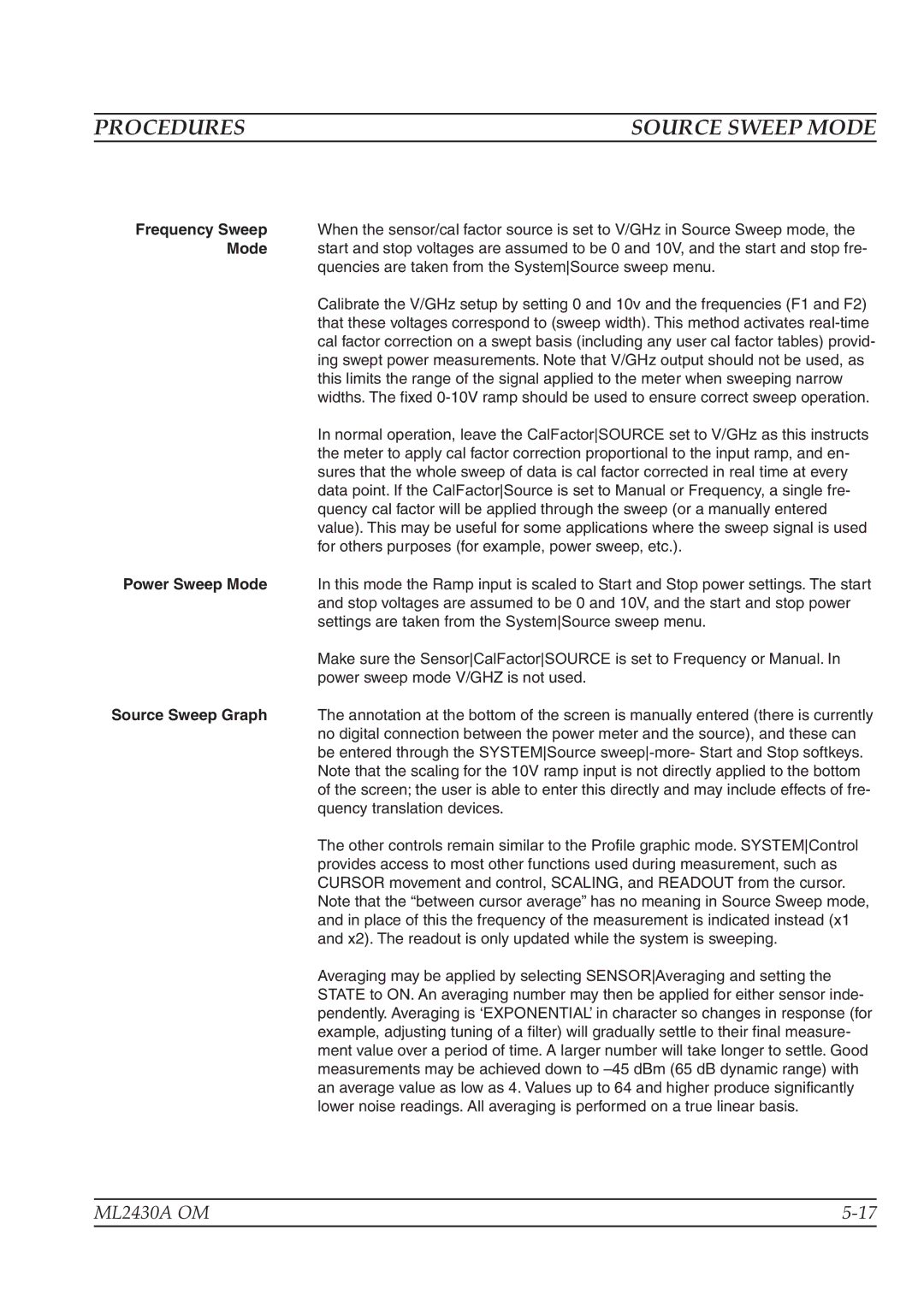
PROCEDURES | SOURCE SWEEP MODE |
Frequency Sweep | When the sensor/cal factor source is set to V/GHz in Source Sweep mode, the |
Mode | start and stop voltages are assumed to be 0 and 10V, and the start and stop fre- |
| quencies are taken from the SystemSource sweep menu. |
| Calibrate the V/GHz setup by setting 0 and 10v and the frequencies (F1 and F2) |
| that these voltages correspond to (sweep width). This method activates |
| cal factor correction on a swept basis (including any user cal factor tables) provid- |
| ing swept power measurements. Note that V/GHz output should not be used, as |
| this limits the range of the signal applied to the meter when sweeping narrow |
| widths. The fixed |
| In normal operation, leave the CalFactorSOURCE set to V/GHz as this instructs |
| the meter to apply cal factor correction proportional to the input ramp, and en- |
| sures that the whole sweep of data is cal factor corrected in real time at every |
| data point. If the CalFactorSource is set to Manual or Frequency, a single fre- |
| quency cal factor will be applied through the sweep (or a manually entered |
| value). This may be useful for some applications where the sweep signal is used |
| for others purposes (for example, power sweep, etc.). |
Power Sweep Mode | In this mode the Ramp input is scaled to Start and Stop power settings. The start |
| and stop voltages are assumed to be 0 and 10V, and the start and stop power |
| settings are taken from the SystemSource sweep menu. |
| Make sure the SensorCalFactorSOURCE is set to Frequency or Manual. In |
| power sweep mode V/GHZ is not used. |
Source Sweep Graph | The annotation at the bottom of the screen is manually entered (there is currently |
| no digital connection between the power meter and the source), and these can |
| be entered through the SYSTEMSource |
| Note that the scaling for the 10V ramp input is not directly applied to the bottom |
| of the screen; the user is able to enter this directly and may include effects of fre- |
| quency translation devices. |
| The other controls remain similar to the Profile graphic mode. SYSTEMControl |
| provides access to most other functions used during measurement, such as |
| CURSOR movement and control, SCALING, and READOUT from the cursor. |
| Note that the “between cursor average” has no meaning in Source Sweep mode, |
| and in place of this the frequency of the measurement is indicated instead (x1 |
| and x2). The readout is only updated while the system is sweeping. |
| Averaging may be applied by selecting SENSORAveraging and setting the |
| STATE to ON. An averaging number may then be applied for either sensor inde- |
| pendently. Averaging is ‘EXPONENTIAL’ in character so changes in response (for |
| example, adjusting tuning of a filter) will gradually settle to their final measure- |
| ment value over a period of time. A larger number will take longer to settle. Good |
| measurements may be achieved down to |
| an average value as low as 4. Values up to 64 and higher produce significantly |
| lower noise readings. All averaging is performed on a true linear basis. |
ML2430A OM | |
|
|
